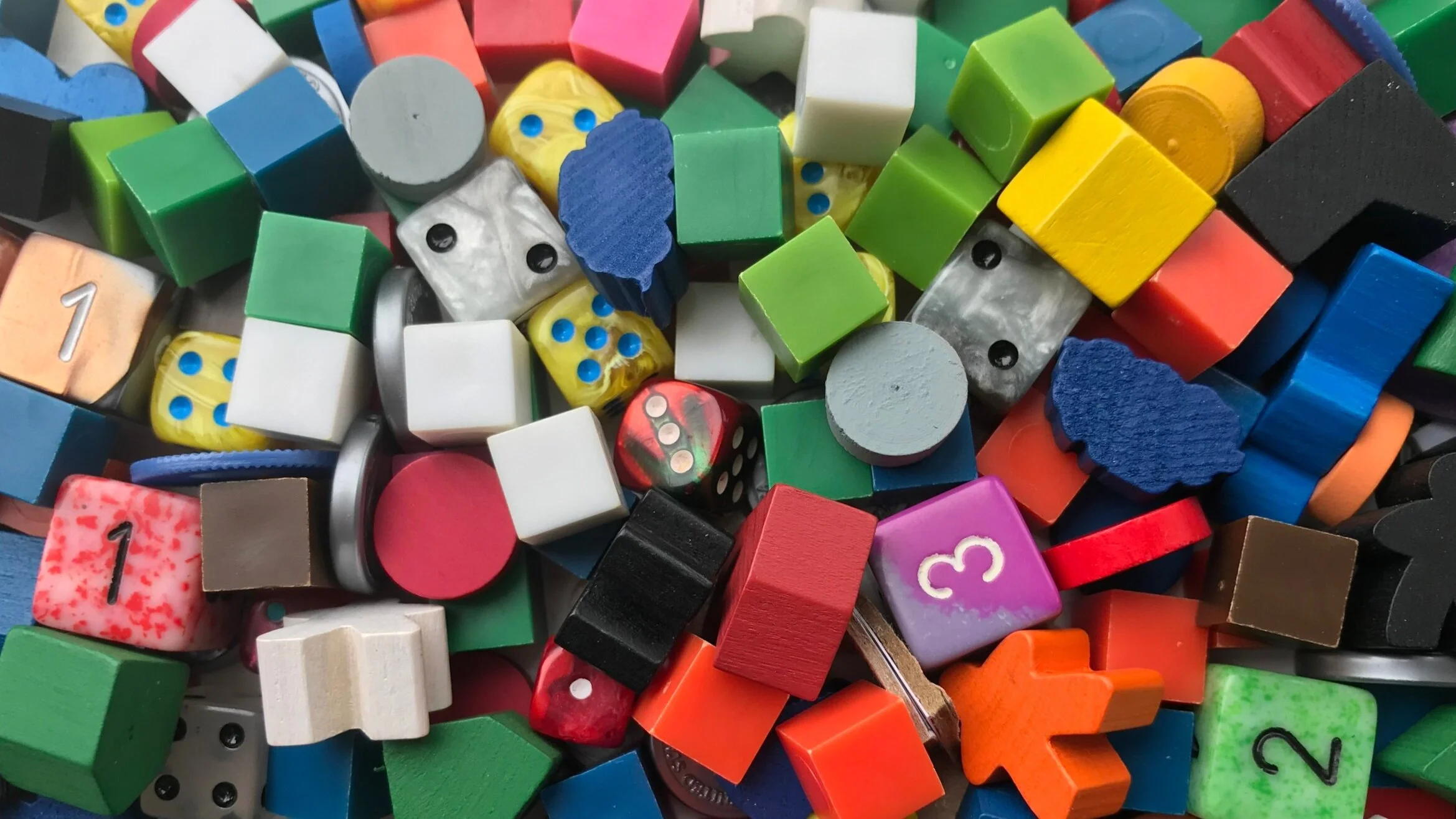Meaningful Decisions: Jesse Catron on Board Game Design Choices
/In our Meaningful Decisions series, we ask designers about the design choices they made while creating their games, and what lessons other designers can take away from those decisions.
In this edition, we talk with Jesse Catron, the designer of fish-racing game Salmon Run, about modular boards, endgame conditions, interactivity and deck-building games.
Salmon Run uses a modular board to increase replayability. How did the game’s board reach its final form, and what should designers watch out for when they create variable setups? Is there a danger of too much variability creating an inconsistent or unbalanced play experience?
My early prototypes had a fixed board. In the back of my mind I knew I would need some way to vary the setup, but I wanted to first concentrate on the game’s mechanisms. Once the mechanics were better refined I would readdress the board. The spatial aspects of all the obstacles and special hexes in Salmon Run are vital to the gameplay, so I knew some variation was needed or else optimal paths upriver would quickly be discovered and the game would become stale. One approach would be to make multiple complete river boards but, again, the problem of optimal paths for each river remains. Also, production costs would increase significantly. It became very evident that a modular system was needed.
There are a few significant things to consider when creating a modular board system. The first is whether one should do so or not. Modular boards are a great way to introduce variability in the game experience while keeping the players engaged game after game. Modularity is a great way to instill replayability. Another plus is the flexibility they provide in varying the game’s difficulty or length or both. Also, with a well-designed modular system, it’s very easy to later add in expansions. The downside is also the variability. Like you mentioned, too much variability can and does create inconsistent experiences. With a fixed board, the designer has complete control over all the board’s interactions. The designer knows with certainty which spaces or resources are beside each other, choke-points can be integrated as desired, and terrain effects can be easily balanced, etc. This is not as easily accomplished with modular boards.
After deciding to use modular boards, a designer should think about what degree of modularity is required for his or her game. The more modular, the more variability but less control. Settlers of Catan is a good example of a very modular system. Each terrain type is its own hex, which can be arranged in countless ways and patterns, and each terrain hex is given a semi-random resource generation value. This allows for a very replayable experience since each setup has new “optimal” locations. The incredibly high amount of variability works well for Settlers because each “board” contains a small amount of information–its terrain type and a number for resource generation–and the boards are redundant with multiples of each type.
On the other end of the modularity spectrum is a game like Kingdom Builder. It uses modular boards in only four quadrants. While a fairly simple system, Donald X. Vaccarino was able to control all the terrain interaction as well as the location and distribution of the special hexes within each quadrant. Maintaining that control in the design is vital to its gameplay, while its small modularity helps prevent the game from becoming stale. Interestingly, he added variable scoring conditions to further increase its replayability.
Salmon Run falls in between these two. It couldn’t be too modular because that could lead to impassible areas, nor could the modules be too large and easily “solvable.” In the end, I made them just large enough to balance the obstacles and special hexes while allowing for enough space for consistent junctions between the boards.
That brings me to the next thing to consider about modular boards: how they fit together. Salmon Run is a linear race, so I only had to be concerned with junctions in the vertical direction. The main concern with fitting the boards together was preventing impassible areas, since mechanically the salmon can’t swim backwards and only progress forward. For instance, the modular system should not allow a waterfall to be directly adjacent vertically to another waterfall. So I designed the entrance and exit of each river section to be identical in width and composition so all boards fit together seamlessly.
Depending on the module’s shape and complexity, the designer will have to be concerned with their junctions in one or more directions. Since the junctions between boards were identical in Salmon Run I could use rectangular boards and bisect some hexes. If the junctions aren’t uniform, more complicated modular shapes may be needed, like in Kingdom Builder.
Lastly, a designer should decide how much information or complexity to put in each module. This is very much related to the choice of how many modules to use. The number of modules to use is inversely proportional to the size and complexity contained within each module. A few, large modular boards can contain lots of information and complexity easily, and the designer can more easily balance them and their interactions. Large numbers of small modules are probably best designed with limited information/complexity to prevent aberrant and unwanted board interactions. I’m sure there are exceptions.
In Salmon Run, each river section has its own little theme and set of choices, like taking the shorter direct path over the waterfall or the longer gentle path around it or perhaps a waterfall choke-point to tighten the pack and ensure some fatigue is incurred. The special hexes also tend to be split into choices between say speed (Double Swim) versus maneuverability (Wild), or Bear versus Eagle, etc. I rated each river section as Easy, Medium, and Hard so the game can be accessible to a variety of gamer types. The modularity also allowed me to vary the river’s total length and therefore its playing time.
For me the benefits of using a modular system were great, and those who like the game seem to really enjoy its great replayability. Admittedly, some who don’t like Salmon Run don’t like it because the variable setup in their first play created an experience that was not ideal for their expectations–often a “gamer” who plays a short setup with many easy boards. Particularly in an environment where new games often get judged on one play, there is surely some risk that variable setups will result in a lackluster play experience and cloud a player’s opinion. While a designer can mitigate this somewhat, it’s certainly something to be cognizant of when designing modular boards. Nevertheless, I’m very happy with the modular system I used in Salmon Run and am a huge fan of modular systems in general.
Salmon Run is a racing game where reaching the finish line first isn’t necessarily going to win you the game–you also have to have fewer Fatigue cards than everyone else who reached the end. Why didn’t you go with a simple first-to-finish win condition?
In a racing game, or any game really, each player should start with an equal chance to win. In Salmon Run, and in many games, the player to go first is randomly chosen. It would be unfair to randomly give out a first-player advantage, so it was important that each player had the same opportunity and number of turns to finish the race. A large part of Salmon Run is managing fatigue: avoiding waterfalls or not, attacking other players with the bear, resting in reeds, and pacing oneself. Therefore it was fitting to use fatigue as a factor in the race results. It’s also thematic, salmon that are less fatigued are more fit for procreation.
Deck-building games have a reputation for being low-interaction affairs. You’ve gotten around this in Salmon Run with several take-that cards, like the Bear and the Eagle, and some more subtle cards, like Current. What should designers of deck-builders be aware of in regards to interactivity?
There are many types of gamers. Some are perfectly content to put their head down, build their engine, and play a multi-player solitaire game. Others are more social and crave loads of player interaction. Most fall somewhere in between. Each designer should be aware of his or her target audience and what kind of experience he or she is trying to convey. If you decide to include interactivity, you need to make sure that the method of interaction is not less valuable than not interacting. For example, if I play a card to hurt Player 1 instead of playing a card to help myself, Player 2 benefits most from the exchange. It’s not really benefiting me to interact. The design should lend itself that players will want to interact.
In Salmon Run, I encouraged (or forced) interaction by including a bear card in each deck. Also, the bear can affect multiple players at once, as does the current and rapids. It was designed to be very accessible to both families and gamers, so I knew I wanted interaction but not to the degree where feelings would get too hurt or gamers would scoff at its take-that elements. Consequently, I limited the interactive cards to have fairly mild immediate effects but can have more strategic long-term effects. The bears add fatigue instead of killing you, the current moves everyone (potentially), etc. Also, playing these special cards doesn’t contribute to over-fatiguing your salmon for the turn the way playing swim cards do. There is little to discourage players from interacting.
The key to instilling interactivity is to know your audience, ensure it’s worthwhile for players, limit/mitigate its effects, and make it readily available.










